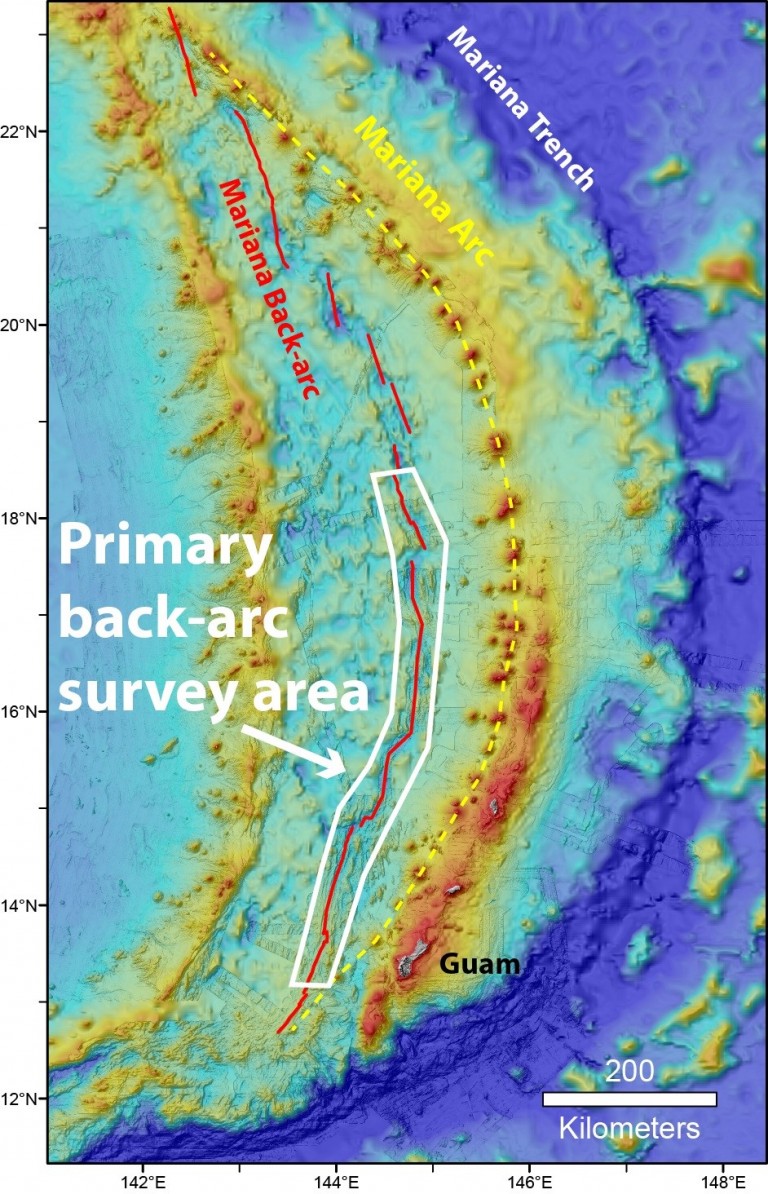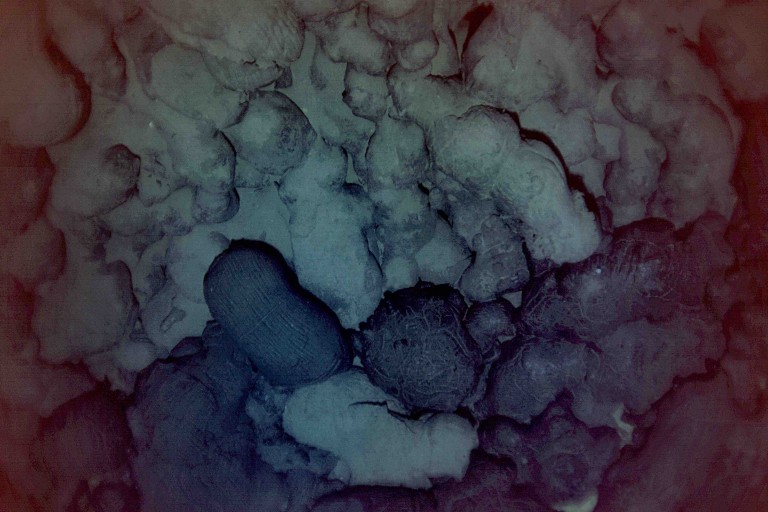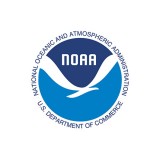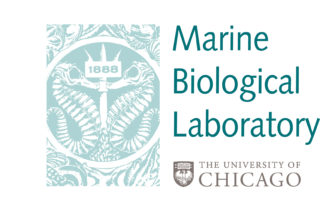Home of the deepest spot on the planet, the Mariana subduction system serves as a valuable natural laboratory for testing ideas about what governs the distribution of animals at hydrothermal vent systems. The deep trench, shallow to mid-depth volcanic arc, and mid-depth to deep spreading back-arc, provide a wide variety of habitats for research. Of these, more than 600 km of the back-arc has remained relatively unexplored. In December 2016, the science team followed up from a discovery cruise that occurred on Falkor the previous winter. During the 2015 visit, three new hydrothermal vents were discovered; one of them being among the deepest vents in the world. This cruise, the team returned with the 4,500m capable ROV SuBastian to explore the life and activity at the vent sites.
Focusing on the Back-Arc
In November 2015, Principal Investigator Joseph Resing, of the University of Washington, led a team of researchers from the University of Washington, Oregon State University, and NOAA/PMEL, went on a 27 day mission aboard Falkor to shed light on the Mariana Back-arc. The team achieved their goal of finding new hydrothermal sites in the Back-arc spreading center and are now planning to return to better understand the biodiversity that shape these unique chemosynthetic ecosystems.
“Chemosynthesis” refers to organisms that transform carbon dioxide into organic matter in the same manner as plants, but, instead of using the energy from sunlight to do this — as in photosynthesis — they use chemical energy instead, mostly from hydrogen, methane, hydrogen sulfide, and iron. Chemosynthetic ecosystems, like the Mariana Back-arc, exist in locations on the seafloor where chemical energy is present from seafloor hot springs, cold seeps, or other microbiological processes.
The Mariana subduction system offers living organisms a range of conditions unlike any other region on the planet. To the west of the trench in the Mariana Back-arc, is a zone of spreading, where mantle magma wells up and new ocean crust is formed. This tectonic environment creates different geophysical and geochemical conditions for the chemosynthetic organisms, reflecting diversity in biological communities on the seafloor.
Return to the Deep
The research from the 2015 cruise helped test the idea that arc and back-arc sites have distinct ecosystems, controlled by each settings’ geology and unique fluid chemistry. To test this hypothesis, several tasks had to be accomplished. The 2015 science team began by finding and identifying active vent sites along the Mariana Back-arc using AUV Sentry, and characterizing each site by its depth, geologic setting, temperature, chemical composition, and rise height of hydrothermal plumes. This follow-up 2016 expedition allowed scientists to return with Schmidt Ocean Institute’s brand-new 4,500 m capable remotely operated vehicle (ROV) SuBastian to visually explore and sample the newly found vent sites on the seafloor.
The team combined the 2015 model with biodiversity data from this 2016 cruise to better define the relationships between geologic setting, chemical environment, and biological communities. One basic goal was to catalog the life forms found at these vents, their affinities, and their relation to the regional biogeography. Researchers expected surprises, given how little exploration has been done on the Back-arc — recent work conducted at other Back-arc sites led researchers to find huge hairy snails never before seen. The team led by Dr. David Butterfield from JISAO, University of Washington, examined the chemistry and geology of the vents, studied their microbiology, and tested ideas to explain the substantial biological differences between the volcanic arc and back-arc vents.
Partial support for this expedition comes from the NOAA Ocean Exploration and Research Program and the NOAA Pacific Marine Environmental Laboratory.
Written by: Logan Mock-Bunting
Data & Publications
30-day Preliminary Cruise Report, Operations Log, and Area of Operations Figures.
The resulting shipboard dataset is being archived at the Rolling Deck to Repository and is now available.
Bathymetry and ROV SuBastian Data is archived at Marine Geosciece Data System and is now available.
All of the rock and biological samples collected by ROV SuBastian have been given International Geosample Numbers (IGSNs). This spreadsheet details each sample and provides the link to more details of each geosample. To learn more about the samples, visit the IGSN Catalog Search and enter the IGSN.
The hydrothermal vent metagenomes have been archived at NCBI, describing the microbial communities in venting fluids from newly discovered hydrothermal vents along the Mariana back-arc spreading center.
The metagenome assemblies have been archived at the Integrated Microbial Genomes & Microbiomes Database.
Repository data for the publication Unique Solid Phase Microextraction Sampler Reveals Distinctive Biogeochemical Profiles among Various Deep-sea Hyrothermal Vents can be found in Zenodo.
A new deep-sea hot vent stalked barnacle from the Mariana Trough is registered with ZooBank.
- Final Cruise Report: Searching for Life in the Mariana Back-Arc [full version with logs)
- Final Cruise Report: Searching for Life in the Mariana Back-Arc [without logs)
- Baker, E., Walker, S., Resing, J., Chadwick, Jr., W., Merle, S., Anderson, M., Butterfield, D., Buck, N., and S. Michael. (2017). The Effect of Arc Proximity on Hydrothermal Activity Along Spreading Centers: New Evidence from the Mariana Back-Arc (12.7° - 18.3°N). Geochem. Geophys. Geosyst.. Accepted Author Manuscript. doi:10.1002/2017GC007234. [This article has been published as OPEN ACCESS].
- , C, , M., , S., , J., , E., , D., , S., and (2017). Geological interpretation of volcanism and segmentation of the Mariana back-arc spreading center between 12.7°N and 18.3°N, Geochem. Geophys. Geosyst., 18, 2240–2274, doi:10.1002/2017GC006813. [This publication is available as OPEN ACCESS].
- Anderson, M., Chadwick, Jr., W., Merle, S., Resing, J., Baker, E., Walker, S., Hannington, M., and N. Augustin. (2017). Relationship between Tectonism, Volcanism, and Hydrothermal Venting along the Mariana Back-arc Spreading Center between 12.7N and 18.3N. Oral Presentation at AGU Chapman Conference on Submarine Volcanism, Hobart, Tasmania, AUS.
- Chadwick, Jr., W., Merle, S., Kaiser, C., Baker, E., Walker, S., Resing, J., Butterfield, D., Baumberger, T., Anderson, M., Shore, P., Wiens, D., and Rubin, K. (2017). A Recent Volcanic Eruption Discovered on the Central Mariana Back-arc Spreading Center. Oral Presentation at IAVCEI 2017 General Assembly, Portland, OR, USA.
- Chadwick, W., Tunnicliffe, V., Butterfield, D., Bates, A., Huber, J., Trembath-Reichert, E., Bobbitt, A., and Merle, S. (2018). Newly Discovered Hydrothermal Vent Sites Along the Mariana Back-arc Spreading Center Support Hypothesis of Geological and Chemical Control on Chemosynthetic Ecosystems. Poster Presentation at Ocean Sciences Meeting, Portland, OR, USA.
- Baker, E., Walker, S., Resing, J., Chadwick, W., Merle, S., Anderson, M., and D. Butterfield. (2018). Hydrothermal Activity Along Back-Arc Spreading Centers: The Importance of Arc Proximity. Poster Presentation at Ocean Sciences Meeting, Portland, OR, USA.
- Chadwick, W., Merle, S., Baker, E., Walker, S., Resing, J., Butterfield, D., Anderson, M., Baumberger, T., and A. Bobbitt (2018), A recent volcanic eruption discovered on the central Mariana back-arc spreading center, Front. Ear. Sci., 6:172, doi:10.3389/feart.2018.00172. [This paper is published as OPEN ACCESS.]
- Butterfield, D., Chadwick, Jr., W., Larson, B., Tunnicliffe, V., Bates, A., and K. Roe (2018). 2016 Exploration Shows Contrasting Fluid Chemistry and Hydrothermal Vent Communities Between the Mariana Arc and Back-Arc. Oral Presentation, 2018 Ocean Sciences Meeting, Portland, OR, USA.
- Tunnicliffe, V., Bates, V., Butterfield, D., and B. Larson (2017). Diversity of the Mariana biogeographic region with a closer look at Alviniconcha hessleri, the original “hairy snail”. Oral Presentation, 6th International Symposium on Chemosynthesis-Based Ecosystems, Woods Hole, MA, USA.
- Butterfield, D., Chadwick, Jr., W., Larson, B., Bates, A., and Tunnicliffe, V. (2018). 2016 Exploration Shows Contrasting Fluid Chemistry and Hydrothermal Vent Communities Between the Mariana Arc and Back-Arc. Oral Presentation, Ocean Sciences Meeting, Portland, OR, USA.
- Trembath-Reichert, E., Butterfield, D., and J. Huber. (2019). Active subseafloor microbial communities from Mariana back-arc venting fluids share metabolic strategies across different thermal niches and taxa. The ISME Journal, doi: 10.1028/s41396-019-0431-y.
- Komai, T. and Giguere, T. (2019). A new species of alvinocaridid shrimp Rimicaris Williams & Rona, 1986 (Decapoda: Caridea) from hydrothermal vents on the Mariana Back Arc Spreading Center, northwestern Pacific. Journal of Crustacean Biology, rus046, doi: 10.1093/jcbiol/ruz046.
- Huber, J., Trembath-Reichert, E., and Butterfield, D. (2018). Application of Stable Isotope Probing Coupled with -omics to Examine Thermophilic Autotrophy in Newly Discovered Hydrothermal Vents Along the Mariana Back-arc. Oral Presentation at AGU Fall Meeting, San Francisco, CA, USA.
- Grandy, J., Onat, B., Tunnicliffe, V., Butterfield, D., and Pawliszyn, J. (2020). Unique Solid Phase Microextraction Sampler Reveals Distinctive Biogeochemical Profiles among Various Deep-sea Hydrothermal Vents. Sci Rep 10, 1360, doi: 10.1038/s41598-020-58418-4. [This article has been published as OPEN ACCESS].
- Breusing, C., Johnson, S., Tunnicliffe, V., Clague, D., Vrijenhoek, R., and Beinart, R. (2020). Allopatric and Sympatric Drivers of Speciation in Alviniconcha Hydrothermal Vent Snails. Molecular Biology and Evolution, 37(12), 3469-3484, doi: 10.1093/molbev/msaa177. [This article has been published as OPEN ACCESS].
- Giguere, T. and Tunnicliffe, V. (2021). Beta diversity differs among hydrothermal vent systems: Implications for conservation. PLOS ONE 16(8), doi: 10.1371/journal.pone.0256637. [This article is published as OPEN ACCESS with support from SOI].
- Breusing, C., Castel, J., Yang, Y., Broquet, T., Sun, J., Jollivet, D., et al. (2022). Global 16S rRNA Diversity of Provannid Snail Endosymbionts from Indo-Pacific Deep-sea Hydrothermal Vents. Environmental Microbiology Reports, doi: 10.1111/1758-229.13051. [This article has been published as OPEN ACCESS with support from SOI].
- Hauer, M., Breusing, C., Termbath-Reichert, E., Huber, J., and Beinart, R. (2023). Geography, not lifestyle, explains the population structure of free-living and host-associated deep-sea hydrothermal vent snail symbionts. Microbiome, 11 (106), doi: 10.1186/s40168-023-01493-2. [This article has been published as OPEN ACCESS with support from SOI].
- Brunner, O., Chen, C., Giguère, T., Kawagucci, S., Tunnicliffe, V., Watanabe, HK., et al. (2022). Species assemblage networks identify regional connectivity pathways among hydrothermal vents in the Northwest Pacific. Ecology and Evolution, (12)12. doi: 10.1002/ece3.9612. [This article has been published as OPEN ACCESS].
In the News
Sustainably exploring life in the deep ocean through chemistry
University of Waterloo • April 23rd, 2020
Unexplored ocean depths bustling with life
Saipan Tribune • December 22nd, 2016
Schmidt Ocean Institute Completes Expedition to Deep-Sea Hydrothermal Vents
Dive Photo Guide • December 22nd, 2016
Cannibalistic deep-sea crabs groom each other like chimpanzees
New Scientist • December 16th, 2016
Unexplored Ocean Depths Bustling with Life, Despite Extreme Conditions
The Guam Daily Post • December 25th, 2016
Rare high-quality footage shows newly discovered deep-sea black smokers in amazing detail
International Business Tribune • December 29th, 2016
Video: ROV Explores Chimney Life
Maritime Executive • December 29th, 2016
Caring crabs are also cannibalistic
The Wire – India • January 4th, 2017
Scientists Find Life at Unexplored Ocean Depths
Marine Technology News • January 14th, 2017
Pictures Reveal One of the Last Unexplored Places on Earth
National Geographic • January 17th, 2017
Breathtaking New Video Footage of the Ocean’s Uncharted Depths
Gizmodo • January 19th, 2017
Photos Reveal One Of The Last Unexplored Places On Earth
Waterfront Times • January 26th, 2017
Uncharted Depths: Exploring the Marianas with SuBastian
Marine Technology News • March 21st, 2017
Cannibalistic Deep-Sea Crabs Groom Each Other Like Chimpanzees
Spring Hill Insider • December 6th, 2019








